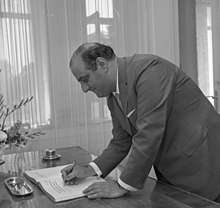Lebanese Uruguayans
There are about 53,000[1] to 70,000[2] Lebanese Uruguayans, or Uruguayans of Lebanese origin. The Lebanese are one of the larger non-European communities, though still not as large a group as most European groups.[2] Relations between Uruguay and Lebanon have always been close.[3]
 Alberto Abdala, a lawyer and politician of Lebanese descent, who served as member of the National Council of Government (1963-1937) and, later, Vice President of Uruguay (1968-1972). | |
| Total population | |
|---|---|
| 53,000[1] to 70,000[2] (%5 of Uruguay's population) | |
| Regions with significant populations | |
| Montevideo, Chuy | |
| Languages | |
| Uruguayan Spanish, Lebanese Arabic | |
| Religion | |
| Christians (majority) and Islam (minority) |
History
The first Lebanese immigrants to Uruguay arrived in the 1860s, settling in Montevideo around Juan Lindolfo Cuestas street.[4] These early immigrants were mainly Maronite Christians, speaking only Arabic. The last great influx of Lebanese came in the 1920s along with other nationalities like Syrians and Europeans. Between 1908 and 1930, Montevideo's population doubled.[5] Some of them also settled in the frontier city of Rivera.[6]
On January 21, 1924, the Apostolic Missionary of Maronites was established by decree in Uruguay. On March 10, 1925, Monseñor Shallita arrived in Montevideo from Naples to lead the mission.[7]
The early settlers faced some discrimination as "Asiatics",[8] and a few were unable to adapt and returned to their homeland. However, most became established as small businessmen and entrepreneurs, and successfully adjusted to the society of their adopted country. Although retaining some cultural characteristics, notably the Lebanese cuisine, most Uruguayans of Lebanese origin no longer speak Arabic and have fully assimilated.[9]
In 1997, the house speaker of Uruguay visited Lebanon and met Patriarch Sfeir. He noted that the 99-seat parliament in Uruguay included two members with Lebanese origins including himself.[10] In 1954 there were 15,000 people of Lebanese descent living in Uruguay.[11] By 2009 the number had grown to between 53,000[1] and 70,000.[2] In July 2009, the Lebanese Society in Uruguay celebrated its 75th anniversary.[12] The 2011 Uruguayan census revealed 136 people who declared Lebanon as their country of birth.[13]
The majority of Lebanese-Uruguayans are Christians who belong to various churches, including the Maronite Church (they have their own church, Our Lady of Lebanon),[14] Roman Catholic, Eastern Orthodox and Melkite Catholic. There was also a small presence of Lebanese Jews.[15] A scant number are Muslims.
Notable Uruguayans of Lebanese origin
- Felipe Seade (1912 – 18 January 1969) was a social-realist painter and teacher born in Santiago de Chile, the elder son of a Lebanese immigrant family, who spent most of his life in Uruguay after moving to Montevideo at the age of 12.[16]
- Alberto Abdala (1920–1986), born of Lebanese immigrant parents, was a Uruguayan politician and painter who was Vice-President of Uruguay from 1967 to 1972. He was noted for his abstract compositions in oil on glass.[17]
- Amir Hamed (1962), Uruguayan writer and translator
- Jorge Nasser (1956), musician
- Dahd Sfeir (1932-2015), Uruguayan singer and actress
- Bruno Sfeir is a well-known painter whose work shows Cubist, Constructivist and surrealist influences, somewhat reminiscent of the school of art initiated by Uruguayan artist Joaquín Torres García.[18][19]
- Jorge Chediak is a lawyer and judge, member of the Supreme Court.
- Malena Muyala (1971-), singer
References
- "Geographical distribution of the Lebanese diaspora". United States Committee for a Free Lebanon. Retrieved 2009-07-04.
- "Les Libanais d'Uruguay" (PDF) (in French). Archived from the original (PDF) on 2013-01-08. Retrieved 2009-07-16.
En Uruguay, ils sont actuellement quelque 70 000 habitants d'origine libanaise (troisième communauté après les Espagnols et les Italiens)
- "Embassy of Uruguay in Lebanon". Embassy of Uruguay in Lebanon. Archived from the original on 2013-01-08. Retrieved 2009-07-04.
- "La inmigración libanesa en el Uruguay" (in Spanish). Colectividad Libanesa en el Uruguay. Archived from the original on October 27, 2009. Retrieved 2009-07-04.CS1 maint: unfit url (link)
- "The Consolidation of Political Democracy". U.S. Library of Congress. Library of Congress Country Studies. 2009. Retrieved July 18, 2009.
- "Subjectivity and frontierland" (in Spanish). Brecha. 15 November 2019.
- "¿Quiénes somos? Nuestra señora del líbano ruega por nosotros" (in Spanish). Nuestra Señora del Líbano. Archived from the original on March 18, 2008. Retrieved 2009-07-04.CS1 maint: unfit url (link)
- "Lebanon, our privileged partner in this region of the world" (PDF). Monday Morning magazine (Lebanon). Archived from the original (PDF) on 2013-01-08. Retrieved 2009-07-08.
- Antonio Seluja (2002). Los libaneses en el Uruguay (in Spanish). Arca (Montevideo). p. 191. ISBN 9974-40-804-0.
- "News from Beirut". Lebanon.com. August 26, 1997. Retrieved 2009-07-04.
- "Visitor from Lebanon". Time magazine. May 24, 1954. Retrieved 2009-07-04.
... Uruguay, where there are 15,000 Lebanese ...
- "Eventos de la Colectividad Libanesa en el Uruguay". Colectividad Libanesa en el Uruguay. Archived from the original on October 27, 2009. Retrieved 2009-07-04.CS1 maint: unfit url (link)
- "Immigration to Uruguay" (PDF) (in Spanish). INE. Archived from the original (PDF) on 16 August 2013. Retrieved 6 March 2013.
- "Maronite Lebanese in Uruguay" (PDF) (in Spanish). Retrieved 15 May 2013.
- "100 years of Jewish institutional presence in Uruguay" (PDF). ORT Uruguay (in Spanish). Retrieved 21 May 2019.
- "Felipe Seade". Alicia Seade-Delboy. Archived from the original on 2004-03-24. Retrieved 2009-07-09.
- "Pintor Alberto Abdala" (in Spanish). 4Pixels SRL. 12 July 2004. Archived from the original on 27 May 2011. Retrieved 2009-07-09.
- Laura Wilkinson (July 30, 2008). "Bruno Sfeir's surrealism: beyond the fronteras of nation states". The Daily Star, Lebanon. Retrieved 2009-07-09.
- "Pulling together". United Nations Interim Force in Lebanon magazine. February 2008. Archived from the original on 2013-01-08. Retrieved 2009-07-09.
External links
- Mary Elizabeth Wilkie (1973). The Lebanese in Montevideo, Uruguay. University of Wisconsin.
- "Association of Young Lebanese Uruguayans" (in Spanish). Archived from the original on 2016-11-17. Retrieved 2009-07-08.
- Renzo Pi Hugarte. "La asimilación cultural de los siriolibaneses y sus descendientes en Uruguay" (PDF) (in Spanish). Retrieved 2 February 2015.